sizzle awards |
 |
 With more than 300,000 people "liking" its Facebook page by the time of the show, Wizards of the Coast LLC focused its online effort on the world's most popular social networking service. With more than 300,000 people "liking" its Facebook page by the time of the show, Wizards of the Coast LLC focused its online effort on the world's most popular social networking service.
 A custom-made app introduced the game's three factions: Thay, Bregan D'Aerthe, and New Neverwinter. A custom-made app introduced the game's three factions: Thay, Bregan D'Aerthe, and New Neverwinter.
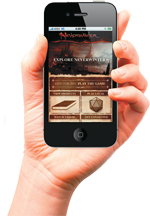
The app also provided the game's rules and info on "Neverwinter."
Compared to the ruckus Wizards was making on- and offline, other exhibitors were about as noticeable as a dog whistle next to a tornado siren.
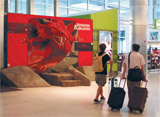
A dragon's head sporting a Quick Response (QR) code
at the airport thrust attendees into the game before they even collected their luggage.
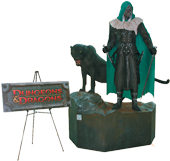
Attendees were greeted by a 12-foot-tall Fiberglas statue of "D&D" character Drizzt Do'Urden in
the convention
center lobby.
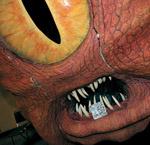
The company placed QR codes near seminar rooms and tournaments, and even on its monsters.
Players searched for a succession of QR codes posted in various locations on the show floor and beyond.
 Each day began with
a procession of staffers
who transported a
desired tiara from the game across the show floor.
Each day began with
a procession of staffers
who transported a
desired tiara from the game across the show floor.
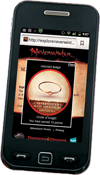 
When a QR code was scanned, the app displayed a piece of armor correlating
to players' factions and delivered a
message such as, "Circlet of Insight. You have earned 15 points!"

Once players scanned all the codes, they went to Wizards' booth to choose one of two final codes, called "Glory and Honor" and "Personal Riches." Those who chose "Personal Riches" received a branded T-shirt. |
|
| SOCIAL MEDIA |
Exhibitor: Wizards of the Coast LLC
Creative/Production: 3D Exhibits Inc., Elk Grove Village, IL, 800-471-9617, www.3dexhibits.com; Hanson Dodge Creative, Milwaukee, 414-347-1266, www.hansondodge.com; QR Wild LLC, Webster, NY, 585-466-4580, www.qrwild.com
Show: Gen Con Indy, 2011
Budget: $125,000
Goals:
 Interact with 25 percent of attendees. Interact with 25 percent of attendees.
 Achieve 3 million impressions via social media outlets. Achieve 3 million impressions via social media outlets.
  Generate 17 million media impressions. Generate 17 million media impressions.
Results
 Interfaced with nearly
45 percent of Gen Con
Indy attendees. Interfaced with nearly
45 percent of Gen Con
Indy attendees.
 Reached 3 million
social-media impressions. Reached 3 million
social-media impressions.
 Scored 28 million mainstream media impressions. Scored 28 million mainstream media impressions.
|
 n 1974, two nerds you never heard of changed the world. That year, Gary Gygax and Dave Arneson brought "Dungeons & Dragons" to market. Riffing on their previous medieval-combat games, Gygax and Arneson performed a bit of alchemy that would have impressed any wizard worth his wand in the Middle Ages. But instead of transmuting mere slabs of lead into bars of gold, these two transformed a mere game into a monster goldmine. n 1974, two nerds you never heard of changed the world. That year, Gary Gygax and Dave Arneson brought "Dungeons & Dragons" to market. Riffing on their previous medieval-combat games, Gygax and Arneson performed a bit of alchemy that would have impressed any wizard worth his wand in the Middle Ages. But instead of transmuting mere slabs of lead into bars of gold, these two transformed a mere game into a monster goldmine.
Now familiarly known as "D&D," the role-playing game involves players whose characters journey about a make-believe world, searching for magical treasures guarded by a menacing menagerie of more than 200 creatures, ranging from eel-like aboleths to acid-spewing zombies.
Spreading across the pop-culture landscape like a video of cute puppies on YouTube, "D&D" has been played by more than 25 million people, has sold in excess of $1 billion worth of games and game-related equipment, and has spun off into countless books, movies, merchandise, and a Saturday-morning cartoon show.
The game, made and sold by Wizards of the Coast LLC, inspired other online role-playing games such as "Everquest" as well as seminal video games, including "Doom" and "Quake." A cultural force that rivals the Lord of the Rings franchise for its scope and sweep, the "D&D" brand is recognized by 89 percent of the 61 million U.S. males between the ages of eight and 45. Indeed, with its legions of fans playing the game for years, "D&D" has fostered a fraternity as tight as any band of brothers.
But when Wizards, which has owned "D&D" since 1997, wanted to promote "Neverwinter," a new supplement for the game, the Renton, WA-based company faced a marketing challenge that ranks up there on the "difficult meter" with mastering the game's infamous 20-sided dice. The company needed a strategy that would appeal to the average gamer, pegged by Electronic Software Association as being male, 30 years old, and with 12 years of gaming experience.
Like video and role-playing games themselves, the company's marketing dilemma possessed increasing layers of hazards and hindrances because the average gamer falls squarely into the generation known as millennials, aka generation Y. Born between 1981 and 2000, they're the demographic that loves brands as much as they loathe them. "Gamers are very serious about their games. We had to make absolutely sure our strategy stayed true to both the 'D&D' characters and the camaraderie that's one of the hallmarks of the game," says Toby Maheras, event marketing manager at Wizards. "We had to find an unusual way to connect them to the new game that didn't reek of overt marketing."
To woo these mercurial millennials, then, Wizards would have to promote its product in an unusual way gamers felt was expressly designed for them. But woo - and wow - them Wizards did, with an effort that one Sizzle Awards judge called, "One of the most innovative and involved social-media campaigns we've ever seen."
With the help of 3D Exhibits Inc., an Elk Grove Village, IL-based exhibit house, the company decided its strategy to promote "Neverwinter" should build on the deep bonds of community forged among "D&D" players and their résumés of role-playing experience. The best way to leverage its customers' telltale characteristics, Wizards reasoned, was to offer something literally every single one of them indulged in regularly, even compulsively: a game. To be precise, a scavenger-hunt game that beckoned with the competitive teamwork millennials crave.
Game of Phones
Calling the game "Mass Adventure," the company and 3D eschewed the expected. Instead of the usual trappings of physical games, such as boards and game pieces, it opted for smart phones, social media, and Quick Response (QR) codes. After all, they reasoned, these technologies formed a digital vernacular its customers spoke fluently. Backing up that hunch was the Pew Research Center's Internet & American Life Project, which showed that 61 percent of online Americans now use social-networking sites daily. Moreover, the ESA's research found 62 percent of gamers engage in game play with others, either in person or online, while 33 percent of gamers play on their smart phones.
"We reasoned the gamers would love this because it would create a world unto itself where they play with and compete against each other, just as in a regular game," says Michael Seymour, senior vice president at 3D. "The social-media and technology aspects would help foster a community among them, and they would be
immersed in the brand."
After settling on a concept it tailored to its customers' particular traits, Wizards then focused on the battleground where it would roll out its strategy: the 2011 Gen Con Indy, an annual gaming convention held in Indianapolis. Launched in 1968, the "nerdstock" currently draws about 36,000 attendees who explore board, role-playing, card, and computer games. In an audacious effort to think outside the booth, the company and 3D decided the scavenger hunt would span not just Wizards' exhibit and the convention center, but parts of the Indiana capital itself. Thus, the sheer time suck of a game spread over such a wide geographical expanse meant participating attendees would have less opportunity to dally at the many other quirky exhibits.
Wizards set pre-show objectives
as ginormous as the Ettin, "D&D"'s two-headed giants: Generate 3 million social-media impressions, exceed the 17 million media impressions achieved at the 2010 show, and jack up the percentage of Gen Con Indy attendees who interact in some way with the "D&D" brand above the usual average of 25 percent. Ultimately, Wizards hoped its scavenger hunt would spark a critical mass of publicity that would then ripple outward to the 170 million gamers throughout the United States.
Preparing for Battle
One week before Gen Con Indy opened its doors in August of 2011, Wizards began sounding a clarion call to the show's attendees and the "D&D" community at large. The company sent an e-mail blast to its database of players, while show management also broadcast a similar electronic mailing to the show's registered attendees. All communiques issued the same simple instructions: Download a QR code reader (if they didn't already have one), as well as a special custom app from the Wizards "Neverwinter" microsite that would work in conjunction with any QR code reader. Meanwhile, the company released a series of 21 posts on its "D&D" Facebook page that alerted followers to the "Mass Adventure" game and offered instructions on how they could sign up to play.
Developed jointly for Wizards by Milwaukee-based Hanson Dodge Creative and QR Wild LLC of Webster, NY, the Facebook page, microsite, QR codes, and app were a seamless entree for players into the "Mass Adventure" world. Not only could players move back and forth between each branded segment with a few clicks on their smart phones; they could also see visuals from the game, read instructions on how to play, post to their own Facebook pages, and delve into info on the "Neverwinter" world.
While Wizards created a Twitter hashtag (#massadv) and coaxed players to use it, the company mainly focused on its Facebook efforts. With more than 300,000 people already "liking" its Facebook page at the time, Wizards felt the social-media site offered a better opportunity for the game to build on its established base.
After players downloaded and fired up the app, they had to offer their contact info and then choose one of three factions to play for, based on competing characters in the "Neverwinter" world. They could choose between: New Neverwinter, who appealed to those seeking justice and order; Thay, who attracted anyone lusting for magical energies that would gain them power; and finally Bregan D'Aerthe, who beguiled players hungering for profits. Once they volunteered for a given band, the players received the rules of the contest. They had to seek out a succession of QR codes posted in a variety of locations encompassing the show floor and beyond. While five were mandatory, a sixth bonus QR code would be added on the last day of the show that players could scan for extra points.
Every QR code a player scanned racked up a set number of points for his or her given faction; the teams' cumulative scores would be displayed on a constantly updated leader board in the Wizards' booth. To keep everyone in the game until the end, Wizards would shake things up with the surprise bonus code on the trade show's last day. That way, those players lagging behind could quickly exploit the bonus to grab the lead.
Let the Games Begin
Wizards started the experience for attendees arriving at the Indianapolis International Airport with a mix of the ordinary and off the wall. For the four days that Gen Con Indy took place, each of the dozen 65-inch monitors in the baggage-claim area invited people to play "Mass Adventure." Of course, it's entirely possible they didn't notice the televised summons to take part, what with a 14-by-8-foot dragon's head glaring at them from the nearby wall. Attendees who instantly got the "D&D" reference flocked to the synthetic stone basilisk for a photo op and to scan the 4-by-4-inch QR code posted on its front. Not only was their awareness of "D&D" refreshed by the mounted hellion's head, the code whisked them to the same website as the one on Facebook that prepped them for the game.
For those who arrived by other methods of transportation, there was yet another easy opportunity to get into the game. Guests bedding at the Westin Indianapolis hotel could access the same QR code from any of the 3,500 key cards the company had specially printed. One of the city's largest hotels, the Westin boasts almost 600 rooms, and a covered skywalk connecting it to the convention center.
The gambit paid off as lucratively as winning the Indianapolis 500: The QR codes garnered 1,096 hits from the hotel key cards and 300 from the dragon's head at the airport. By promoting "Mass Adventure" before the show through social media and e-blasts, mobilizing players into competitive teams, and then teasing them with visual cues at the airport and hotel, Wizards guaranteed that thousands of attendees would already be deeply immersed in the game before Gen Con Indy opened its doors. Compared to the ruckus Wizards was making on- and offline, other exhibitors were about as noticeable as a dog whistle next to a tornado siren.
"D&D" Day
Eager for their particular faction to crush the others, players rushed through the convention center's lobby the moment the show opened. There, Wizards greeted them with a painted, 12-foot-tall Fiberglas statue of Drizzt Do'Urden. Once the players hit the show floor, they swarmed toward the Wizards' exhibit. Prepped by the pre-show instructions to search for the first of five obligatory QR codes there, attendees descended on the 40-by-50-foot booth with phones in hand. More than a quick pit stop, however, the Wizards booth arrested them with a variety of activities, resources, and physical reminders of the game that submerged them even further in the experience.
Each day of the show, for example, the company staged a procession of up to six staffers, with two of them outfitted like characters from "Neverwinter." Marching to the booth, the staffers drew the stares of attendees as they held aloft a coveted tiara from the game. The players could interact with the staffers, who stayed in character, as well as pick up a button showing what faction they belonged to.
Twin back-to-back 50-inch LCD flatscreen monitors listed teams' standings as well as the top 25 individual players who had piled up the most points throughout the day. Themed banners hanging next to the monitors were switched out each day to represent the team currently in the lead. Before they left the booth, players checked a list of locations where other QR codes could be found. Then they bolted to go find the codes as if they had mainlined a 55-gallon drum of 5-Hour Energy drink.
Wizards stuck the codes in carefully selected places that it calculated would further forge a link between the brand and the players. Thus, the first two codes were positioned at opposing ends of the convention center's Sagamore Ballroom, where the company had taken two additional spaces. Here in the 33,000-square-foot ballroom, players discovered one code in an area dedicated to teaching "D&D" to newcomers, while its counterpart at the other end offered a round-the-clock "D&D" tournament for hard-core game veterans. Wizards also stationed a code in a seminar room at the adjoining Marriott hotel, where it hoped players might take a breather and attend sessions offered by Bob Salvatore and Ed Greenwood, authors of several popular "D&D"-based books.
Gamers do not live by Hot Pockets and Mountain Dew alone, so Wizards wisely placed a QR code in Scotty's Brewhouse, a popular pub a few blocks away from the convention center. Designated the official "D&D"-sponsored Gen Con Indy after-hours hangout by Wizards, the company designed a special "D&D" menu, tempting ravenous players and other famished patrons with delicacies like the Elder Brain Burger and the
Cinnamon Roll of Annihilation.
Game Change
Just as Wizards had employed social media to help hype the game before the show, the company used the technology to fan the flames throughout it, too. Wizards' staff tweeted and posted regularly on Facebook to provide play-by-play color commentary. On the second day of the show, for example, a posting to its Facebook page read: "Day 2 is now complete. Even though Thayans are rallying, they still cannot catch up to compete in the very close battle between the New Neverwinter and Bregan D'Aerthe factions. We will be sharing clues about where the Bonus Code is hidden starting tomorrow morning. A decision is looming that will change the game ... Stay tuned." Later on, the company broadcast the names of partners' booths where supplemental codes would be posted, so even teams behind in the standings could boost their point totals and perhaps sprint from behind to victory. The steady stream of messages and updates via social media literally kept the thousands of players in the game, following the ever-mutating standings and taking advantage of scoring opportunities to drive their opponents into the digital dust.
If individual players wanted to strut their stuff, they could post their scores directly from the app to their Facebook
pages and Twitter accounts, thereby increasing the universe of people exposed to the game and the "D&D" brand by thousands. Just as importantly, the app let players access the back story of "Neverwinter" and the lore behind the factions. Bit by bit, like the extreme gamers involved in the play-until-you-drop "D&D" tournament, attendees' entire daily existence at the show was rooted in "Neverwinter." Where they went, what they read, and even where they ate was influenced by the game and its effective use of social-media tools to keep them engaged.
After players had located all of the codes, the app invited them to revisit the Wizards exhibit where they could rack up even more points for the neck-and-neck teams. In the booth, staff members presented them with a "Moral Dilemma." They were offered a choice between two QR codes, dubbed "Glory and Honor" or "Personal Riches." Once they decided, players scanned the appropriate QR code and received a corresponding message. Those opting for "Personal Riches" read their large fate on their small phones: "Congratulations, your quest for 'The Crown' has now ended. You have chosen personal greed over faction glory. You have earned a special treasure from Dungeons & Dragons. Present this page to the appropriate warden in the Sagamore Ballroom beginning Sunday 8/7 until 3pm." These players received a branded T-shirt. Like the greedy plutocrat in "Indiana Jones and the Last Crusade" who impulsively grabs and drinks from a bejeweled but poisoned chalice thinking it was the Holy Grail, these players chose poorly.
Players selecting "Glory and Honor" were bestowed with a clap-on-the-back message and a more enriching fate: "Congratulations, your quest for 'The Crown' has now ended. As a true hero you chose glory. You have earned an additional 725 points for your faction." Indeed, those on the faction named for Bregan D'Aerthe had spread the word via texts that this was the better choice, using 21st century social media to thrust themselves like a 13th century catapult into the winners' circle. Their prize was paid in tribute for the victory, not mere threads. Later, Wizards announced the Bregan faction as the victors on its Facebook and Twitter accounts.
Victory is Thine
Nearly 13,000 attendees competed in "Mass Adventure," an astonishing 36 percent of Gen Con Indy's overall attendance. Add that number to those who visited the booth, played in a "D&D" tournament, or chomped on vittles at Scotty's Brewhouse, and the sum of attendees interacting with the brand flirts with roughly 45 percent of the show's total attendance.
With about one out of every three attendees participating in the game, the company easily eclipsed its goal of 3 million social-media impressions by nearly 20 percent, including 3.5 million newsfeed impressions, 700 Facebook and 400 Twitter posts by players, and 19,000 visits to its website. Post-show analysis revealed 35 percent of these online interactions came via mobile devices, vindicating the smart-phone-centric strategy that made it easy for attendees to play the game and immerse themselves in the branding experience.
Wizards also smashed its target of 17 million mainstream media impressions with the force of a mace landing on an unprotected skull: It chalked up 28 million of them, exceeding its goal by nearly 65 percent, thanks to the help of more than 70 print and online pieces, as well as six TV segments. Knowing its audience like Einstein knew E=MC², Wizards created a special world for players that was as imaginary as its success was real. E
|
|
|
|















 n 1974, two nerds you never heard of changed the world. That year, Gary Gygax and Dave Arneson brought "Dungeons & Dragons" to market. Riffing on their previous medieval-combat games, Gygax and Arneson performed a bit of alchemy that would have impressed any wizard worth his wand in the Middle Ages. But instead of transmuting mere slabs of lead into bars of gold, these two transformed a mere game into a monster goldmine.
n 1974, two nerds you never heard of changed the world. That year, Gary Gygax and Dave Arneson brought "Dungeons & Dragons" to market. Riffing on their previous medieval-combat games, Gygax and Arneson performed a bit of alchemy that would have impressed any wizard worth his wand in the Middle Ages. But instead of transmuting mere slabs of lead into bars of gold, these two transformed a mere game into a monster goldmine.


